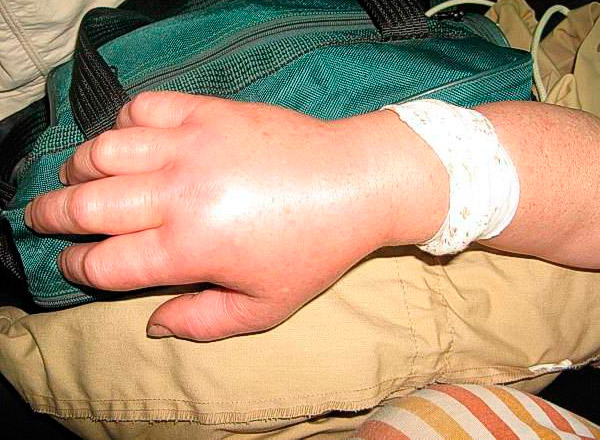Consequences after a viper bite
Last reviewed: 23.04.2024

All iLive content is medically reviewed or fact checked to ensure as much factual accuracy as possible.
We have strict sourcing guidelines and only link to reputable media sites, academic research institutions and, whenever possible, medically peer reviewed studies. Note that the numbers in parentheses ([1], [2], etc.) are clickable links to these studies.
If you feel that any of our content is inaccurate, out-of-date, or otherwise questionable, please select it and press Ctrl + Enter.

Today, increasingly, medical facilities are treated with various injuries, injuries, especially after a rest on the nature. One of the most serious injuries is a viper bite. It causes serious impairment of the functional state of the body, and can also cause the development of an allergic reaction, edema, anaphylactic shock. Bites are not always injected with death, nevertheless, if you do not provide timely first aid, it can end in a fatal outcome.
The most dangerous complication is a strong poisoning of the body, in which the poison affects the entire body, has a systematic effect. At this time the maximum local edema develops, which is accompanied by soreness, swelling, redness, an increase in local temperature.
The process can be accompanied by a violation of blood circulation, minor hemorrhages. Also allergic reaction is dangerous, especially developed by immediate type. The risk of anaphylactic shock increases, which is accompanied by suffocation, progressive swelling, loss of consciousness, fatal drop in temperature and blood pressure.
Edema after a viper bite
Edema is a fairly common reaction that occurs in response to ingestion of a toxin (poison) into the body. Especially intensively, edema develops on the background of an allergic reaction, reduced immunity. Usually the edema is local.
Edema can be accompanied by a violation of blood circulation, a violation of the function of blood. Vascular thrombosis develops, hemorrhages in the internal organs. The infection and the development of the inflammatory process can become dangerous. As a result, edema develops, thrombosis of the vessels develops, a local metabolic disorder that, in the absence of adequate treatment, can progress, up to the development of tissue necrosis.

As a result of the action of the poison, severe damage to the muscles and nervous tissue can occur, which is accompanied by a loss of sensitivity, reactivity, and weakening. As a rule, muscles weaken, fingers cease to bend (with defeat of limbs).
Systemic poisoning can be accompanied by an increase in general and local temperature, nausea, vomiting, chills. The activity of the heart muscle worsens, which can progress to the development of severe heart failure. Also, the load on the liver and kidneys is significantly increased, as a result of which the inflammatory process may develop, a functional disorder, including renal and hepatic insufficiency. The blood pressure changes. In some cases, hypotension develops, in others - hypertension. The process can be accompanied by blood loss, including, internal, weakness, clouding of consciousness.
The process can be accompanied by cramps, tremors, tremors in the limbs. All this can be accompanied by increasing excitement, euphoria. As a rule, in the absence of treatment, a lethal outcome develops. Death can occur between 30 minutes and 2-3 days.
Do vipers die from a bite?
Despite the fact that many survive after the bite of a viper, it can not be said that it is safe. The Viper is a poisonous snake, so its bite can result in a fatal outcome. Everything depends on the quality and speed of emergency care. If you start providing first aid right after the bite, the person will survive. It is necessary to immediately suck the poison. If this is not done within 3-5 minutes after the bite, it is absorbed, penetrates into the body and begins to affect the internal organs, having already systemic effects on the body. This can be fatal.
Treatment of the consequences of a viper bite
Anti-edema is effectively helped by alternative and homeopathic remedies. Consider the most effective means.
Well-proven ointment from the spring leaves of chestnut. To make it, you need to take a few leaves of chestnut, chop, then burn them. After the leaves completely burn, and ashes remain, add 2-3 drops of fir essential oil, as well as 2-3 tablespoons of flower honey.
All this is thoroughly mixed, then the resulting mass is applied a thin layer on the affected area. It is advisable to apply it so that it is still hot. So repeat every day until the visible bites, redness, and other afterbite disappear.
The main advantage of this combination of substances is that after burning the chestnut, all dangerous substances that can cause irritation and intensify the inflammatory process are neutralized. At the same time, biologically active substances that promote wound healing remain in the ashes. Oil of fir promotes skin renewal, acceleration of regenerative processes. Honey enhances the activity of all other components that make up the ointment. Also honey sucks the remnants of poison out of the wound, removes the inflammatory process, allergic reaction, dissolves the seals, swelling and bruises. If the resinous mass after burning does not remain, you can dilute the resulting ash in half a glass of warm water, and then add all the other components.
It also works well with ointment from decoction of honeysuckle and honey. To prepare the ointment, take about 50 grams of honey, melt in a water bath, add a pre-prepared decoction of honeysuckle, stir until a uniform mass is formed, allow to freeze. After this, apply a thin layer on the affected area 3-4 times a day. Helps to eliminate the viper bite as early as 4-5 days after the start of treatment.
Read more about the treatment after a viper bite in this article.


 [
[